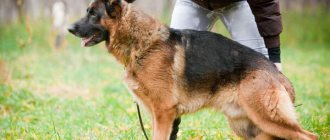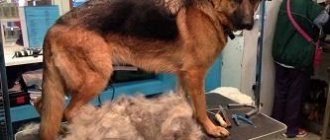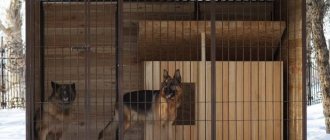Choosing a puppy class
All dogs, regardless of breed, are classified into three classes - show, breed and pet, determined approximately until 5-9 months of age, since the puppy can move from one group to another. The show category includes animals for exhibition and breeding work, which breeders are reluctant to part with. The breed class includes healthy dogs that are less impressive than their show class counterparts, but are also allowed for breeding.
Dogs of the pet category are excluded from selection (they have disqualifying defects or significant exterior defects), which, however, does not affect their quality of life and ability to please the owner.
Important! For show-class German Shepherds the division is even deeper. The most selected “Germans” represent two areas – dogs for show and for service purposes. Both of them participate in exhibitions, but the criteria for their evaluation differ significantly.
Let us remind you that thanks to Captain Max von Stefanitz, the German Shepherd has become the best working dog in the world: it follows the scent, patrols the area, searches for explosives and drugs, herds herds, guides the blind, rescues from avalanches/rubles, protects the house and the owner.
But right now, according to dog handlers, show and working shepherd dogs are so different that they can confidently be classified into two breed groups (with serious differences in appearance and character). The difference is observed in the quality of the nervous system projected onto the dog's behavior. “Germans” of working breeding have a strong but agile psyche with pronounced instincts and an optimal balance of excitation/inhibition .
Working dogs, called "Leistungsucht", exhibit traits such as:
- activity;
- perseverance;
- courage;
- endurance;
- fast reaction;
- stress resistance;
- high adaptability.
The selection of "shousucht" (as opposed to "leistungsucht") focuses on obtaining brightly colored shepherd dogs with exemplary anatomy for spectacular presentation in the ring and photography. Here the nervous system and performance characteristics fade into the background, and the requirements for them become less stringent. Today, not a single show German Shepherd can compete with the Leistungsucht in tournaments where working qualities are tested.
Important! If you need a “German” to pose with in family photos, buy a show puppy. To protect the territory and household members, take a shepherd from the producers of working lines.
Return to content
Is it possible to adopt an adult German Shepherd? - Serious question
The answer is yes! Existing myths about the poor survival rate of an adult dog BUT in a new family are spread by bad owners of a poorly managed dog, who did not bother to find out the reputation of the shepherd dog and its previous owner before purchasing it.
The German Shepherd would not have achieved its status as a great police service dog if it was only oriented towards one person. This is not a one-owner dog!
The versatility of this breed also lies in the fact that the NO accepts a new family and a new environment without any problems, the main thing for it is to have its own business - to serve a person!
Of course, parting with the previous owner has a hard impact on the dog’s condition, but it will not have a destructive effect on its psyche. And the sooner you put your German Shepherd into work, the greater your chances of becoming a new God for him.
If the German Shepherd was properly raised, grew up surrounded by people, has good professional qualities and the reputation of its previous owner is not satisfactory, then such a dog will be quite useful to your family.
Finding out the previous history of the adult OI (why they refuse, what complaints about behavior and other leading questions) is a must!
The reason may be the saddest and most banal - the previous owner died, and the relatives are unable to either maintain or care for the dog.
To avoid any doubts, look at how well-trained German Shepherds and VEOs work in the Middle Kingdom. Here are dogs up to one and a half years old. Some of them will be culled under the ZKS, and they will be sold for a small amount to private owners and breeding nurseries. Won't such dogs delight their new owners?
Choosing the gender of the puppy
When deciding on the gender of your shepherd, think about what kind of difficulties are easier for you to cope with - physiological/household or psychological. The latter will arise when purchasing a male dog, who is a priori more aggressive than a female dog and will definitely try to take the place of the alpha male. Also, a male requires more attention during training, sometimes marks his territory (not always outside the apartment) and becomes uncontrollable when meeting a female in heat.
But males have undeniable advantages:
- they are larger and more massive than bitches;
- Males do not have estrus;
- they are allowed more frequent (once every 2-4 months) matings;
- their owners are spared the hassle of raising puppies;
- purebred males are of interest to breeders.
Bitches are smaller and lighter, they periodically go into heat (fraught with unwanted pregnancy), the consequences of which - giving birth and nursing the puppies - fall on the shoulders of the owner. On the other hand, bitches are more docile and affectionate, so they are easier to train. In addition, females (due to breeding restrictions) are constantly in demand by breeders.
Return to content
What age is best to adopt a dog?
A serious kennel will not give away a German Shepherd puppy until he is 2 months old. During this time, he will socialize and become stronger enough to move to a new family.
Unfortunately, in Russia, puppies often leave the nursery much earlier, at 1 month or a little older, which is explained by economic considerations. A nursing bitch (especially with a large litter) quickly becomes exhausted, and keeping puppies costs a pretty penny.
This is interesting! Sometimes teenagers are put up for sale, which should alert the future owner: perhaps the breeder kept the dog for breeding, but hidden defects were revealed.
When planning to purchase a shepherd, pay attention to the season . Thus, spring puppies are often born weak due to the mother’s winter exhaustion, which, however, can be easily corrected with increased nutrition and care. Also, with a pet bought in the spring, you can (after quarantine) take a long walk in the fresh air.
Litters born in the fall are usually stronger, but require vitamin D supplementation to make up for the inevitable lack of sun exposure. Walks with such a puppy will be short due to seasonal bad weather and cold.
Return to content
Upbringing
The characteristics of the breed imply a strict and demanding attitude towards the animal in order to raise it to be a real watchman and security guard. The baby should not be cuddled or carried in your arms. He must be immediately accustomed to the place of rest and feeding. In a private home, a German Shepherd puppy is placed in an enclosure with a warm booth.
Caring for an animal will become easier if you properly organize your daily routine and consistently follow it. In this case, the dog will quickly get used to doing everything on schedule.
During the first month spent at home, the pupil must learn his nickname. The owner is supposed to say it when addressing the pet, and when it responds, praise and encourage it. Along with the name, you should learn the command “Come to me!”
Young dogs do not yet know how to control their emotions. They often show intense joy at the sight of a person. They can be weaned from jumping on their owner using the following methods:
- soft (for babies) - limited mobility, ignored;
- strict (for teenagers) - splashing or pouring a stream of water.
During walks, the puppy is taught to wear a leash, which allows you to control the pet’s movements and foster obedience. A training course under the guidance of an experienced dog handler completes the training process for German Shepherds.
Choosing a healthy puppy
You should not look for a full-fledged German Shepherd at the poultry market. Even litter from champion sires in a trusted nursery can be very heterogeneous. The most promising puppies are rarely given away, leaving them for breeding, and if they are sold, it is very expensive. Your task is to choose the strongest and most beautiful baby, which is extremely difficult in the absence of special knowledge.
General information
Find out how many puppies the bitch brought. According to FCI standards, German Shepherds should feed no more than ten dogs at a time, which is considered the key to their future health. And the bitch herself in this case is less susceptible to exhaustion.
Ask when the dog's previous birth was. If she was whelped less than a year ago, it is better to abandon the puppy: according to European rules, a breeding shepherd dog should give birth no more than once a year. Frequent childbirth weakens both the mother and her offspring.
Important! Consider the bitch - during lactation she looks thinner and tired, and is also actively shedding. Do not confuse shedding with patchy baldness (an indicator of disease). Malaise is indicated by discharge from the eyes and a cracked, dry nose.
Assess the litter as a whole. A high-quality litter is usually homogeneous - all puppies are approximately the same size (allowing for the difference between the sexes) and are similar to each other.
Compliance with standard
There are many anatomical details that allow you to understand the high class of litter. A good German Shepherd puppy has the following characteristics:
- strong bones and elongated body;
- straight (not sagging) back and strong (not short) neck;
- thick paws, gathered into a ball (hind paws without dewclaws);
- lack of fringe in the ear area;
- tail without kinks or bumps;
- ears without erect tips up to 3.5 months;
- scissor bite with a gap between the incisors of no more than 2 mm (without fused/double teeth);
- the muzzle is not sharp, the forehead is not too wide (with a pronounced transition between them).
Important! If the pet is not involved in breeding, it may have a light color and light (not brown) eyes. Sometimes animals with different eyes are born, which can only be pets.
In menstruating Germans, a bluish tint to the iris is allowed, which disappears as they grow older. The standard eye color is dark brown. Puppies come in black and tan or black: the more intense the tan color, the better.
Puppy health
Take a closer look at the environment where the puppies are growing up. In puppy nurseries, piles are quite acceptable, as long as there are no blood clots in them. Liquid feces will also indicate an intestinal disorder. By the way, sometimes diarrhea is indicated by characteristic marks near the anus and on the “pants”.
Puppies are expected to exude fun, optimism and curiosity . They should be free of flaking and scabs, and their coat should be plush and clean. Dull, tousled fur, complemented by a bloated belly, is a sign of helminthic infestation.
Warning symptoms include:
- large hernias (umbilical/inguinal);
- visible consequences of birth/postpartum trauma;
- thickenings on the ribs, indicating rickets (identified by palpation);
- purulent discharge from the eyes;
- odor from the ears;
- dry nose.
This is interesting! An unpleasant smell from the ears signals an inflammatory process (otitis media), in which the puppy scratches the ear, shakes its head and shows obvious anxiety.
If you want to test your dog's hearing, clap your hands sharply and watch his reaction.
Puppy makings
A dog's character is no less important than its physical health. Pay attention to the puppy, bravely exploring space, confidently interacting with littermates and people. The adaptive qualities of the “German” first appear precisely when he is weaned from his mother: at this moment he shows his fearlessness and willingness to communicate with a stranger.
It’s bad if the puppy hides in a corner, runs away and hides. But the other extreme, when he tries to bite and growls angrily, does not characterize him from the best side. Developing a distrustful attitude towards strangers will become your prerogative and will begin after you take the dog home.
Return to content
How should you choose a puppy?
When choosing a German Shepherd puppy, you need to consider the following nuances:
- If there are more than 6 babies in a litter, then they are unlikely to be large, since mother’s milk will not be enough for their full development.
- If the puppy has dull fur and is not very active, it means he has worms or some kind of disease.
- If a puppy behaves too aggressively, then it may grow into a very angry dog, and its owner will have difficulties in raising it. Excessively fearful behavior may indicate a mental disorder or trauma.
- When examining a baby you like, it is necessary to assess the condition of his teeth to ensure that the bite of the breed is present, and that the ears and coat are clean.
- The puppy must be moderately well-fed, its paws must be positioned correctly.
- If nodes are felt on the ribs, this indicates a lack of calcium in the body and the presence of rickets.
- There should be no irritation or wounds on the belly and paw pads. If they are present, the puppy was poorly cared for and had to sleep on its own feces.
- There should be no signs of an umbilical hernia on the stomach, which most often appears due to an improperly cut umbilical cord, which the baby constantly steps on.
- There should be 4 toes on the hind legs. If fifth toes are present, they will have to be removed surgically, as they are considered a defect.
- There should be no curvature in the tail, the body has a sloping croup, good angulation, a short loin and metatarsals.
The coat should be thick and dense
How much does a German Shepherd puppy cost?
The desire to save money when buying a German Shepherd always backfires . By saving your money, you will receive a mixed breed or a puppy from an unscheduled mating. In both cases, you will not be given documents guaranteeing, among other things, the absence of congenital defects and mental disorders.
The price for a purebred German Shepherd starts at 20 thousand rubles, but puppies from titled parents cost twice as much, usually 35–40 thousand rubles.
Return to content
What documents should there be?
The only official document certifying the breed of a German Shepherd is its pedigree or (at first) a puppy card. These documents are issued by breeders who have permission from the RKF for breeding.
In turn, the RKF, as a member of the FCI, enters all breeding German shepherds into a common database where you can trace the origin of the dog not only at the level of its parents, but also more distant ancestors. Producers, especially in the working sector, pass standards, undergo health testing (including dysplasia), are evaluated at special breed exhibitions and receive diplomas.
Important! The test results are entered into pedigrees and reflected in the database. The authenticity of the dog is verified by its brand and chip. Any tournament or exhibition event begins with checking the number on the dog’s right ear and in its pedigree.
A serious breeder will not forget to draw up a purchase and sale agreement, which spells out in detail the responsibilities of both parties.
Return to content
What to feed?
To feed the dog, use a bowl on a stand. When eating, the stance is fixed: the hind legs form a 90-degree angle at the joints, and the front legs are parallel to each other. This is how the little dog learns to stand correctly. Next to the feeder there should be a drinking bowl with clean water at room temperature, it is updated at least 3 times a day. At the end of the meal, wipe the puppy's face.
First, the baby needs to be given the same food that the previous owner gave. They are gradually transferred to a new type of food. German Shepherds at home are fed either natural food, prepared independently, or commercial food (dry or wet). Combining both types is not recommended.
With a natural diet, it is necessary to carefully observe the proportions of various products and prepare food several times a day. Food must be supplemented with vitamins for healthy and full development. You cannot give your dog food from the owner's table.
Starting from 2 months of age, the pet is offered raw bones with cartilage, which contain many substances beneficial to the body. If your puppy doesn't eat them well, you should carefully examine his teeth and gums. It is possible that the dog has dental problems.
Many breeders believe that it is better to feed babies with ready-made food, it is more convenient and more profitable. The daily intake of dry food directly depends on its class: the lower the class, the lower the nutritional value and the higher the consumption. The most profitable are holistic foods, enriched with nutrients and close in taste to natural food. It is not recommended to give economy class to German shepherds (author of the video My Dog Ru - Training and raising a dog).
Breeders' advice
If you are purchasing a German Shepherd puppy in hopes of raising him to be a champion (show or working line), you will need to remember a few key points.
- The first is that the bitch who brought the puppy must have a pedigree that proves her blood ties to a family that produced many known offspring. If a bitch has whelped for the first time, her closest female relatives, mother and grandmother, must produce high-quality litters.
- Secondly, the bitch’s genetic makeup is not enough to give birth to good puppies. The male dog must also have equal innate characteristics: the more impressive the list of his victories, as well as the list of titled male relatives, the better.
- Third, you need to look for a puppy in kennels with an impeccable reputation that have been conducting long-term breeding activities with the German Shepherd breed. Here they follow modern trends in breeding and guarantee excellent quality of litters.
Körung
A far-sighted buyer will make sure of the health of the producers (mental and physical), for which he will ask the breeders for kerkarts of the female and male.
This is interesting! Kerkarta is a basic document of breeding German Shepherds, which describes the exterior, character, working qualities and behavior. Recommendations for using the dog in breeding work are included in the kerkarta.
Regulation SV specifies the minimum age of “Germans” allowed for breeding: 24 months for males, 20 months for females. Korung is a regular event where breeding sires are selected taking into account their anatomical data, behavior and working qualities.
Before passing the kerung, the German Shepherd undergoes a comprehensive check, consisting of several stages:
- passing a training exam;
- endurance testing;
- undergoing diagnostic testing for dysplasia;
- participation in a breeding exhibition (with a rating of at least “good”).
Kerung includes an examination of the shepherd and a description of the exterior, as well as a test of courage (fighting qualities). In addition, other data is included in the card (degree of dysplasia, absence of eye diseases and mental disorders). After the shepherd dog has passed the Kerung, it is assigned 1st (it is considered the highest) or 2nd Kerung class.
Character Definition
German Shepherds, recognized as universal dogs with high adaptability, “kick” from time to time, demonstrating their not the most positive traits:
- independence flowing into disobedience, oh;
- relative stubbornness – in 15% of dogs;
- pronounced obstinacy – in 10%.
Not all German Shepherd owners achieve an ideal relationship in a dog-human pair. To help those who have acquired service breeds, tests have been developed that reveal the individual characteristics of puppies (with suitability for the type of training).
Campbell's tests are recognized as the most revealing . However, it depends on the owner how the dog will grow up. A person has the power to soften the negative manifestations of a pet and enhance its positive properties.
Return to content
Target selection of puppies
The choice of a puppy must be approached extremely responsibly, because the dog will be in constant contact with the owner for the next 10 years. A pet requires constant attention, care, love and financial investment. Following on from this, you need to decide why you need a dog. Then you can start choosing your favorite.
For exhibitions
First, you should know that choosing a dog suitable for exhibitions is only half the battle. An important role is played by training courses (not only general, but also special), proper nutrition and the ability to work with the handler - the person showing the dog at the exhibition. Luck is also important, because a dog can compete at shows for only 5-8 years.
Before purchasing a future “artist,” you need to study his pedigree, which must include certain achievements and awards. This significantly increases the chance of success, but does not guarantee it. Even in the most promising litter with champion parents there may be only 1-2 puppies that inherit the outstanding abilities of their ancestors. The rest grow up to be ordinary ordinary dogs. To get a guarantee that the dog will become a champion, it is better to buy an already adult, trained breeding specimen with show awards. Its price will be much higher than the cost of puppies, but in the future it can save you from even greater expenses.
For exhibitions, you need to select a bony and strong dog, which, at the same time, is mobile. Much attention should be paid to the dog’s exterior. It is important to remember that the presence of dewclaws in German Shepherds can be a reason for disqualification from exhibitions. If they are not removed before six days after birth, this can be done at 12-16 weeks.
A dog can be disqualified from an exhibition not only because of conformation defects, but also because of behavior uncharacteristic for the breed. For example, an unsure or overly aggressive shepherd will most likely be excluded from participating in the event.
Disqualifying faults of a German Shepherd:
- long guard hair;
- deformation of the tail or ears;
- cryptorchidism (anomaly of testicular descent);
- deformities;
- white color;
- defects of the jaw or dental system;
- cowardice, aggression, nervousness.
For sports competitions
Following the surge in popularity of world and national training championships, a distinct population of dogs for “working breeding” has emerged.
A sporting dog must have high performance, toughness in defense, speed and a strong temperament. At the same time, the anatomical shape is not as important as for show dogs. The puppy's parents should have many awards from sporting competitions.
When choosing a future sports winner, attention is paid to behavior. Ideally, the puppy should confidently run towards a stranger, inviting him into play by grabbing hands and clothes. Such a pet plays with great concentration and interest. Any signs of wariness or fear in a puppy indicate the inadvisability of purchasing it for competitions.
For breeding
There is a common belief that dog breeding is a very profitable business. This is not always the case, since keeping pets is not cheap. In addition, you should not expect that buyers will appear immediately, because most people prefer to buy dogs from experienced and well-known dog breeders with many awards and consistently producing high-quality puppies. All this can come with time, but it will inevitably be preceded by a significant amount of wasted nerves and money.
Buying a dog with good breeding prospects is not easy, because the best puppies from a successful litter are rarely sold. But even if this was possible, there is again no guarantee that an outstanding dog will grow up. First of all, you need to identify the puppy's hereditary potential. To do this, they study his pedigree. Parents must prove themselves to be good producers.
When choosing between a female and a male, you should be guided by your taste. Males are subject to more stringent breeding requirements. They also eat more. The bitch is more organized, loyal to the owner and easier to train. It should be remembered that a bitch is still more suitable for creating a nursery, since it is on the breeding material that such organizations are formed.
For special service
The German Shepherd is the most popular working dog breed. She is easy to train and has a coat that is ideal for the climatic conditions in our country. This breed also has a good sense of smell, so it is an indispensable assistant in the search for drugs, explosives or missing people. Due to a good reaction, a German Shepherd can save the life of its owner.
For special service, you should choose balanced dogs with a sanguine type of nervous system. A mandatory requirement is the active processes of inhibition and excitation. Service dogs must have developed muscles, strong bones, good eyesight and sense of smell, healthy teeth and a strong grip.
You can start training at the age of 8-16 months. It is not recommended to train puppies at all, since they are not able to withstand significant physical activity.











